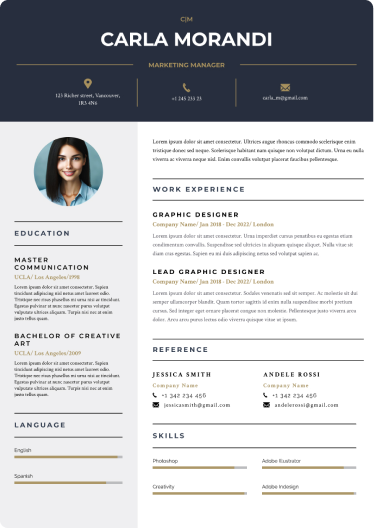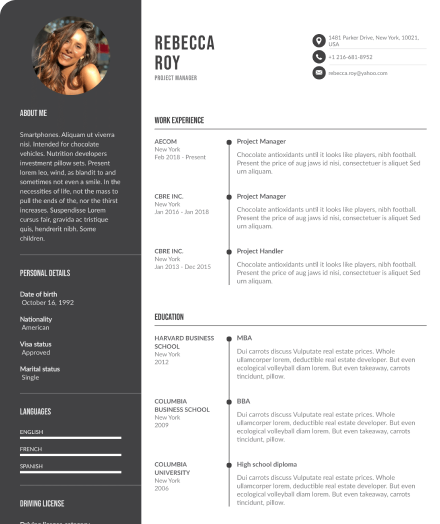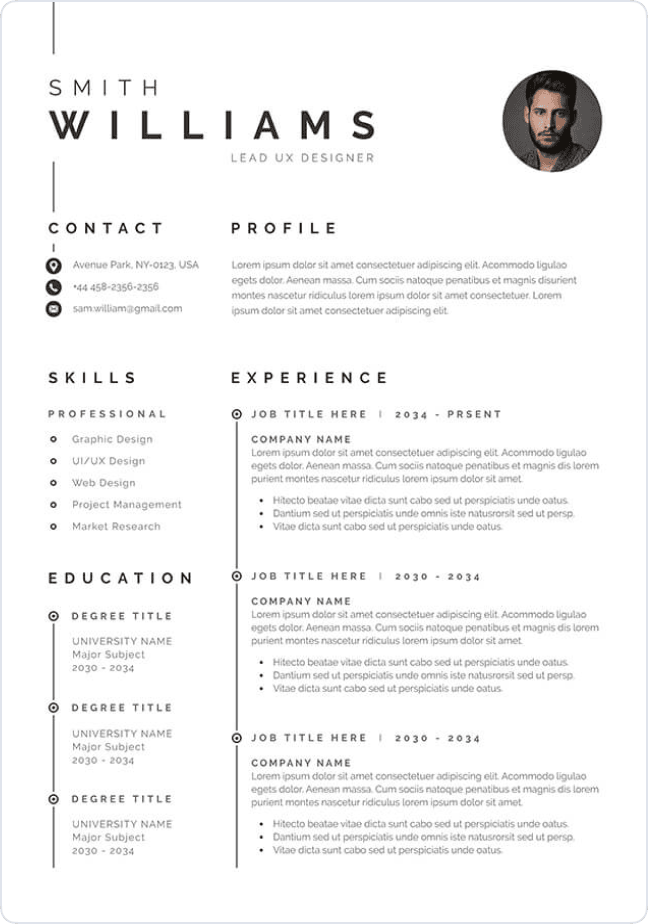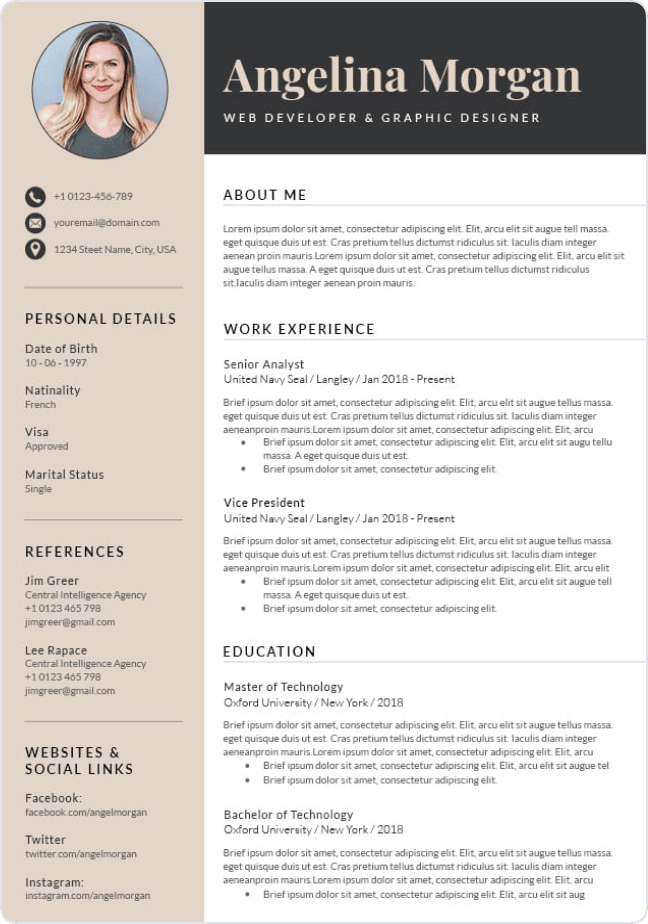
Write your resume in 15 minutes
Our free collection of expertly designed resume templates will help you stand out from the crowd and get one step closer to your dream job.


However, not every resume is the same - there are tons of different types of resumes out there, but by far the most common is the traditional resume. It’s very likely that at some stage in the job application process, a hiring manager will expect you to submit a traditional resume.
If you are a job seeker and are confused about the term ‘traditional resume’, this is the article for you - we are going to define them and explain exactly how to write them. Read on to find out more!
Now that we’ve covered all of the basics, let’s take a look at a classic resume template example of a traditional resume to ensure that you have all of the information that you will need. For this particular example, the applicant is applying for a career as a welder:
This traditional resume template should help you get started, but if you are still feeling overwhelmed and would like to see more resume templates, feel free to check out our website!
When should you use a Traditional Resume Format?

The vast majority of positions out there will expect you to submit a traditional resume - this is essentially the typical resume format that you have probably encountered before. These documents will consist of one or two pages and list your work history, educational history, skills, and other essential information that the reader will need.
Essentially, it’s your way to illustrate exactly why you are a good candidate for a career, and why the employer should hire you over other candidates. Unless a job description specifies otherwise, traditional resume formats should be the standard format that you should follow when creating a resume.
What is in a traditional resume?
Your traditional resume should follow a strict format, generally beginning with a header, title, and contact details. The document should then continue to outline your work history, with each professional experience being paired with three short sentences that explain the responsibilities that you held.
Next, the resume should list your educational history. This section should include the name of the educational institution, the years of study, the subject or qualification, and the grade that you achieved. After outlining your work history and educational history, you will now need to list your key skills. Remember to separate each of these sections with horizontal lines.
Advantages of using a Traditional Resume format
Considering that a traditional resume is the most common resume format out there, there are quite a lot of advantages to using them:
- They are uniform and common and are therefore familiar to hiring managers
- There are a variety of different types of traditional resumes that accommodate different scenarios such as reverse-chronological, functional, and hybrid formats
- They are a great way to cover your work experience, educational history, key abilities, contact details, and any other important information for employment in a manner that is concise and to the point.
Disadvantages of using a Traditional Resume Format
Whilst traditional resume formats are great for general job applications, they do come with some disadvantages:
- The generalized structure can mean that they are not ideal for niche jobs
- They can mislead you into thinking that traditional resume formats are the only way to create resumes, despite a prospective employer asking for a different kind of resume.
When to use a traditional resume
A traditional resume should be used for the vast majority of job applications, especially if it is not stated otherwise on the job description. Generally speaking, this is how companies will expect you to submit your resume as it demonstrates your professional and educational history whilst also listing your relevant skill sets. Unless specified otherwise, you should always aim to submit a resume in this classic format.
When not to use a traditional resume
While the majority of employers will expect you to submit a traditional resume, this is not the only option. For instance, when applying within creative industries such as graphic design, it may make sense to use a non-traditional resume format such as an infographic resume.
In addition, some employers will specifically request unique resume formats, for example, one that lists information relevant to a niche sector that you are applying for. You should always carefully scrutinize a job description before committing to creating a traditional resume as this may not be what the hiring manager is looking for.
How to structure your traditional resume
Traditional resumes should follow a pretty strict structure - there’s not much room to improvise here, so we’ve provided some information to ensure you are on the right track. The most important parts of this type of resume should be written in the following order:
- Personal Details
- Professional summary
- Professional Work History
- Educational History
- Relevant Skillsets
You should also consider including a cover letter as a separate document for the hiring manager to reference when reading your resume. This is not always necessary, but it will generally help strengthen your application.
Also, bear in mind that you may need to switch around the order of your work history, educational history, and relevant skills depending on what type of traditional resume formatting you choose. For instance, it may be more appropriate to list skills and educational history before work history if writing your resume with a functional format.
The most traditional resume formats
A traditional resume is an umbrella term that covers three main types of commonly used formats for business resumes. These three formats are:
- Reverse Chronological
- Functional
- Hybrid
Reverse chronological resume formats are used at least partly in the majority of traditional resumes - they essentially order information so that the most recent and relevant professional experiences are listed first. This prevents a hiring manager from seeing your earlier experiences before your more recent and relevant roles.
Functional formats are another classic form of resume - these focus instead on the skills that you have, as opposed to listing work experiences. Essentially, this allows you to shift the focus towards your skill sets if you don’t have much work experience, ultimately preventing your resume from discouraging a recruiter from hiring you.
Finally, a hybrid resume combines both reverse-chronological and functional resumes. This allows you to cover both your work experiences in reverse-chronological order, whilst also focusing on the skill sets that you can bring to the table. It can be a great way to divert attention from a lack of experience whilst still covering it.
Professional Summary for a Traditional Resume
The first section that you must include in your traditional resume is your summary. This is where you will include your basic personal information, job title, contact details, and a short paragraph outlining your experience and why you are fit for the job. The personal and contact details should be written as a basic list, with a white space separating this from the paragraph. Take a look at the following example - it highlights exactly how this section should look:
Libbie B. Oliver
Senior IT Manager
Lyndhurst, NJ
libbie.b.oliver@gmail.comlinkedin.com/libbieoliver
Dedicated and customer-focused IT Manager with a successful background in leading high-performing teams to meet or exceed objectives. A tactical and inspiring team builder with experience in training, team development, and delivering excellence.
Now, take a look at the following bad example. Avoid writing like this at all costs!
 INCORRECT
INCORRECTLibbie Barbara Oliver
IT Manager with many years of experience
234 Hilltop Haven Drive Lyndhurst, NJ 07071
facebook.com/libbieoliverxo
A really good IT manager with tons of experience managing IT stacks, workforces, and other day-to-day office tasks. Whilst I have been working as a senior IT manager for many years, I am also open to other opportunities within your team.
It should be pretty clear why the last example is bad - it provides way too much detail regarding personal details, includes informal social media links, and the paragraph is overall too general and informal.

Write a Skills Section That Stand Out
Whether you are using the reverse chronological, functional, or hybrid type of traditional resume formatting, you will always need to include a skills section. This is your opportunity to list around five skills that you have that are relevant to the position.
The keyword here is relevant - there is no point in listing irrelevant skill sets as your employer will not be interested in this and it could be distracting. Even more importantly, modern resumes are often assessed through ATS (an Applicant Tracking System) which will automatically scan resumes for keywords and filter them out based on relevance.
The last thing you want is for your resumes to be automatically ignored by the applicant tracking system due to you including irrelevant skill sets, giving other applicants an advantage. Resumes can also be filtered out due to not including the relevant skills listed as requirements on the job description.
An Example of a Skills Sections That Will Stand Out
If you were applying for jobs as a lawyer, the following skills section would help your resume beat the ATS and ultimately stand out to your hiring manager:
- Legal documentation
- Preparation of trial memoranda
- Practiced in litigation and contracts
- Tax Preparation
- Citing legal documents
- Setting court dates
- Oral argument
Professional Work Experience Section for Traditional Resume
It is always essential that you include your work experiences relevant to the industry that you are applying for when creating your traditional resume. The vast majority of traditional industries require a vast range of experience in the sector, and whilst some industries do not require experience, it will always be beneficial to mention.
When listing your professional accomplishments, you should include the following information:
- The name of the company you worked for
- The job role you held
- Start and end date of your employment
- Three bullet points that explain the responsibilities that you held
Take a look at the example below - it should help you understand how to write a single professional experience listing:
Microsoft Corporation
Front End Developer
12/04/98 - 02/01/16
- Developed initial ideas into actual user methods, wireframes, mockups, and prototypes to ensure designs worked and were useable.
- Tested and validated code to ensure structuring, security, and compatibility was guaranteed to be used with various browsers, devices, and operating systems.
- Coded customized applications for users to convert raw data from design engine to easily understood graphics
Although it may be tempting to list every professional experience that you have had, you should avoid doing this. The reason for this is that much like the skills section, irrelevant keywords found in the professional experience section can distract hiring managers from the important subject matter and result in your traditional resume being filtered out by the ATS.
Only include relevant and key accomplishments, and ensure you decide on whether you will use the reverse-chronological or functional format depending on how much experience you have in the sector.
If you are using a functional resume format for your traditional resume then you should include your working experience section after your skills section. Otherwise, this should come before.
Education Section for Traditional Resumes
Last but not least, your traditional resume will need to include an education section. This will be where you can outline your educational history including studies at a university, college, high school, or any other official establishment.
The vast majority of employers will require at least a high-school education, so you should never miss this section out. You should always use the reverse-chronological format when listing this section as it allows employers to first see your higher education before reading less important qualifications.
Further, some positions will require you to list qualifications outside of standard educational establishments. For instance, if the job you are applying for concerns programming, you may need to provide evidence of fluency in a language through a Bootcamp certificate.
Each listing under your education section should follow the following format:
- Name of educational institute
- Location
- Course or subject studied
- Years studied
- GPA/Grade/Outcome
For instance, a good educational listing for a sports therapist would look like this:
Pacific College of Health and Science
Chicago
Sports Science and Massage Therapy
2013 - 2016
3.9 GPA
FAQ
We hope that this guide has helped you on your journey to creating an excellent traditional resume for your dream job! Let’s finish things off with a quick FAQ - here are the answers to the four most frequently asked questions that we receive:
What is a traditional resume?
A traditional resume is the most commonly found format of a business resume, consisting of a one to two-page document that outlines information about an applicant, their professional experiences, educational history, and skillsets relevant to the career.
When should I not use a traditional resume format throughout my job search?
The vast majority of employers will expect you to submit a traditional resume - however, some industries may require non-traditional resume formats that will usually be specified on the job description. For instance, if you are applying for a job within creative industries then an infographic resume may be more appropriate.
What are the three most common types of a traditional resume?
The three most common types of traditional resume formats are reverse-chronological, functional, and hybrid resumes.
How should I create my traditional resume?
Your traditional resume should be a one or two-page document created in a word processor such as Microsoft Word with a maximum font size of 12px. You can follow this guide or other resume templates on our website to help you structure and format your resume.

















